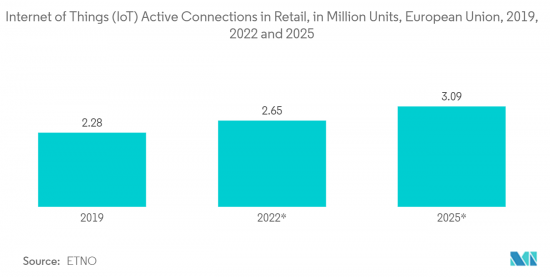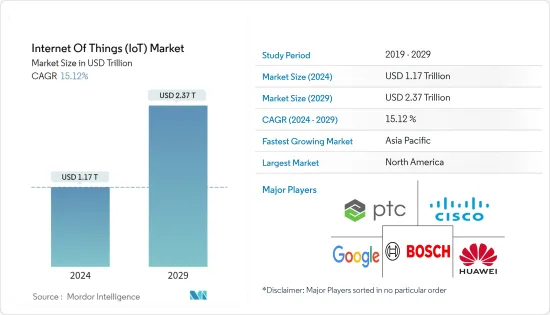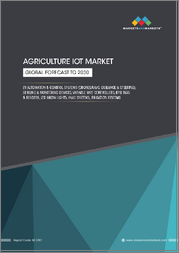
|
시장보고서
상품코드
1403099
사물인터넷(IoT) : 시장 점유율 분석, 산업 동향 및 통계, 성장 예측(2024-2029년)Internet Of Things (IoT) - Market Share Analysis, Industry Trends & Statistics, Growth Forecasts 2024 - 2029 |
||||||
사물인터넷(Internet Of Things, IoT) 시장 규모는 2024년에 1조 1,700억 달러로 추정되고, 2029년에는 2조 3,700억 달러에 달할 것으로 예상되며, 예측 기간 중(2024-2029년)의 CAGR은 15.12%로 추이하며 성장 할 것으로 예상됩니다.

COVID-19 팬데믹 기간 동안 시장의 공급업체들은 여러 조직과 협력하여 의료 기관이 위기를 효과적으로 극복할 수 있도록 새로운 기술 기반 솔루션을 제공하고 있습니다. 예를 들어, 1월 말 상하이 공중보건임상센터(SPHCC)는 캘리포니아에 본사를 둔 커넥티드 헬스 스타트업 VivaLNK의 연속 체온 측정 장치를 사용하여 COVID-19 환자를 모니터링함으로써 간병인이 바이러스에 노출될 위험을 줄였습니다.
주요 하이라이트
- IoT 기술은 다양한 조직이 디지털 트랜스포메이션을 위한 핵심 요소로, 새로운 비즈니스 모델을 만들고 추적하여 기존 프로세스를 업그레이드할 수 있도록 지원합니다. 기업과 서비스 제공업체는 IoT를 디지털 트랜스포메이션을 강화하고 운영 효율성을 높일 수 있는 핵심 요소로 간주하고 있습니다. 제조, 자동차, 의료 등 최종 사용자 산업 전반에서 IoT 기술 채택이 증가하면서 시장의 성장을 긍정적으로 이끌고 있습니다. 전통적인 제조업 분야가 디지털 트랜스포메이션을 진행 중인 가운데, IoT는 지능형 연결이라는 차세대 산업 혁명을 촉진하고 있습니다. 이는 효율성을 개선하고 다운타임을 줄이기 위해 점점 더 복잡해지는 시스템과 기계의 프로세스에 접근하는 업계의 방식을 바꾸고 있습니다.
- 인더스트리 4.0과 IoT는 스마트 팩토리 자동화로 알려진 전체 물류 체인을 개발, 생산, 관리하기 위한 새로운 기술 접근 방식의 핵심입니다. 인더스트리 4.0과 IoT의 수용으로 인한 제조업의 대대적인 변화로 인해 기업은 로봇 공학을 통해 인간의 노동력을 보완하고 증강하는 기술로 생산을 발전시키고 공정 실패로 인한 산업 재해를 줄이기 위해 민첩하고 스마트하며 혁신적인 방법을 채택해야 합니다. 커넥티드 디바이스와 센서의 채택률이 높아지고 M2M 통신이 활성화되면서 제조 업계에서 생성되는 데이터 포인트가 급증하고 있습니다. 이러한 데이터 포인트는 재료가 한 공정 사이클을 통과하는 데 걸리는 시간을 설명하는 지표부터 자동차 산업의 재료 응력 능력 계산과 같은 고급 데이터에 이르기까지 다양한 종류가 있습니다.
- Zebra의 제조 비전 연구에 따르면 2022년까지 IoT와 RFID를 기반으로 하는 스마트 자산 추적 솔루션이 기존의 스프레드시트 기반 방식을 추월할 것으로 예상됩니다. 산업용 IoT(IIoT) 기업 Microsoft Corporation의 연구에 따르면 85%의 기업이 적어도 한 가지 이상의 IIoT 사용 사례 프로젝트를 진행하고 있는 것으로 나타났습니다. 응답자의 94%가 2021년에 IIoT 전략을 구현할 것이라고 답했기 때문에 이 수치는 더 늘어날 수 있습니다.
- 필드 디바이스, 센서, 로봇의 발전으로 시장의 범위가 더욱 확대될 것으로 예상됩니다. IoT 기술은 제조업 분야의 인력 부족 문제를 극복하고 있습니다. 점점 더 많은 조직에서 로봇화와 같은 인더스트리 4.0 기술을 사용하는 것이 일상적인 업무의 일부가 되었습니다. 국제로봇연맹에 따르면 협동 로봇 시장은 2년 안에 123억 달러에 달할 것으로 예상됩니다. 지능형 로봇은 작업자와 함께 작업하며 대부분의 공장 작업자가 가장 일상적이고 지루한 작업을 수행하고 정확하게 전달하도록 프로그래밍할 수 있습니다.
- 지능형 로봇은 훈련하기 쉽고 잠재적으로 위험한 상황에서 사람을 대신하여 작업 환경을 보다 안전하게 만들 수 있기 때문에 제조 업계에서 점점 더 많이 사용되고 있습니다. 고도로 훈련되고 협업이 가능한 로봇은 위험하거나 부적합한 상황에서 인간과 자리를 바꾸어 작업함으로써 인간에게 더 안전한 작업 환경을 제공하기도 합니다. 예를 들어, 광산 현장에서 사용되는 자율주행 덤프트럭은 작업자가 원격으로 제어할 수 있어 사람이 운전할 필요가 없습니다.
사물인터넷(IoT) 시장 동향
소매 부문이 안정적인 성장을 달성
- 소매 산업에서는 가맹점과 최종 소비자 모두가 커넥티드 디바이스의 이용을 촉진하고 있습니다. 전자상거래의 사용과 가처분 소득의 증가는 슈퍼마켓과 대형 마트의 성장을 뒷받침합니다. 소프트웨어 사용과 디지털화, 그리고 인터넷 접속이 필수적인 이 시장 카테고리에서 IoT 디바이스의 시장 잠재력은 매우 높습니다.
- IoT는 또한 저장 시설의 재고 보충과 같은 여러 지역에서 크게 변화할 것으로 예상됩니다. Samsung과 LG을 비롯한 주요 전자제품 생산업체들은 치즈, 우유 등 재고가 부족한 품목을 자동으로 재주문할 수 있는 커넥티드 냉장고와 같은 제품을 출시하고 있습니다.
- 또한 스마트폰의 보급이 진행되고 온라인 쇼핑이 쉬워지면서 전자상거래 플랫폼의 이용이 증가하고 있습니다. 데이터 분석과 애널리틱스 통합의 필요성이 커지고 있기 때문에 시장 성장이 예상됩니다.
- 소매업체를 위한 IoT의 핵심 애플리케이션에는 공급망, 커넥티드 소비자, 스마트 스토어 애플리케이션이 포함됩니다. 소매업체들은 매출을 늘리고 비용을 절감하는 동시에 고객 참여를 개선하는 데 도움이 되는 IoT 지원 솔루션에 주목하고 있습니다.

북미가 안정적인 성장을 달성
- 커넥티드카 도입, 스마트 에너지 활용 프로젝트, 홈 오토메이션, 스마트 제조에 대한 관심으로 인해 이 지역의 중요한 수익 창출 최종 사용자 산업에서 IoT의 역할이 확대되고 있습니다. 이러한 측면에서 북미는 중요한 시장일 가능성이 높습니다. 이 지역에서 IoT의 확장은 산업 부문 전반의 빠른 디지털화와 기술 혁신의 도움도 받았습니다.
- SAS Software와 같은 기업이 IoT 기반 AI의 차세대 물결로 홍보하는 AI와 IoT의 융합은 미국의 제조업을 변화시키고 있는 현재 기술에서 비롯될 것으로 예상되는 미래 기술 중 하나입니다. 현재 미국에서는 유틸리티 부문에 대한 압박이 거세지고 있습니다. 미국 에너지 정보국은 재생 가능 자원을 통한 국내 에너지 생산이 크게 확대되었음에도 불구하고 17년 후 전 세계 에너지 수요가 48% 증가할 것으로 예측했습니다.
- 이 지역은 배포에 더 많은 유연성과 성능을 제공하는 컨테이너 기반 클라우드 애플리케이션을 채택한 선구적인 지역입니다. 중앙 집중식 또는 엣지 IoT 배포는 모두 컨테이너 기반 클라우드 배포에 익숙해지고 있습니다. 예를 들어, VMware는 쿠버네티스의 컨테이너 배포를 제어하는 클라우드 플랫폼인 VMware Tanzu를 출시했습니다.
- 또한 이 지역에는 획기적인 IoT 칩 솔루션을 개발하는 많은 스타트업이 있습니다. 예를 들어, 미국의 스타트업인 Wiliot은 제조, 자재 재활용, 소매, 자산 유통을 위해 배터리가 필요 없는 블루투스 기술 기반의 IoT 칩을 개발합니다. 이 블루투스 태그에는 센서, 저전력 프로세서, 전파 기반 에너지 하베스팅 회로가 통합되어 있습니다. 이 스타트업이 사용하는 배터리 없는 기술은 훨씬 저렴한 가격을 제공합니다.
사물인터넷(IoT) 산업 개요
사물인터넷(IoT) 시장은 국내외 시장에서 많은 대기업과 중소기업들이 활동하고 있기 때문에 경쟁이 심합니다. 기술의 존재감이 높기 때문에 시장은 단편화된 것 같습니다. 제품 혁신과 M&A는 시장 진출기업의 대표적인 두 가지 중요한 기술입니다. Oracle Corporation, Cisco Systems Inc., Google Inc., IBM Corporation, Microsoft Corporation 등이 시장 진출기업의 주요 예입니다.
2023년 4월, Qualcomm은 새로운 산업 용도을 실현하고 IoT 에코시스템의 확장을 지원하는 최첨단 IoT 솔루션을 발표했습니다. 최신 IoT 솔루션은 스마트 빌딩, 기업, 소매, 산업 자동화와 같은 광범위한 IoT 이용 사례를 위한 우수한 성능, 고급 연결성 및 차세대 처리를 제공합니다.
2022년 11월, Texas Instruments(TI)는 사물인터넷(IoT) 애플리케이션에서 매터 프로토콜의 채택을 간소화할 수 있는 Wi-Fi 및 스레드 심플링크 무선 마이크로컨트롤러(MCU)용 새로운 매터 지원 소프트웨어 개발 키트를 출시했습니다. 이 소프트웨어는 커넥티비티 표준 협회와의 긴밀한 협력과 2.4GHz 커넥티비티 분야의 혁신을 바탕으로 개발되었으며, 엔지니어는 새로운 소프트웨어와 무선 MCU를 사용하여 독점 에코시스템 전반의 장치와 원활하게 연결되는 초저전력, 보안, 배터리 구동 스마트 홈 및 산업 자동화 IoT 애플리케이션을 만들 수 있습니다.
기타 혜택 :
- 엑셀 형식 시장 예측(ME) 시트
- 3개월간의 애널리스트 서포트
목차
제1장 서론
- 조사 전제 조건 및 시장 정의
- 조사 범위
제2장 조사 방법
제3장 주요 요약
제4장 시장 개요
- 시장 개요
- 산업의 매력도-Porter's Five Forces 분석
- 공급기업의 협상력
- 구매자의 협상력
- 신규 참가업체의 위협
- 대체품의 위협
- 경쟁 기업간 경쟁 관계의 강도
- 산업 밸류체인 분석
- 규제 프레임워크
- COVID-19의 산업에 대한 영향 평가
제5장 시장 역학
- 시장 성장 촉진 요인
- 커넥티드 디바이스 채택 증가와 기술 보급
- 데이터 분석의 급성장과 기술 진보
- 시장 성장 억제 요인
- 데이터 보안 및 개인 정보 보호, 장치 연결성 및 상호 운용성 문제
제6장 IoT 이용 사례
제7장 시장 세분화
- 컴포넌트별
- 하드웨어
- 소프트웨어/플랫폼
- 커넥티비티
- 서비스
- 최종 사용자 산업별
- 제조업
- 운수
- 헬스케어
- 소매
- 에너지 및 유틸리티
- 주택산업
- 기타 최종 사용자 산업
- 지역별
- 북미
- 유럽
- 아시아 태평양
- 남미
- 중동 및 아프리카
제8장 경쟁 구도
- 기업 개요
- Huawei Technologies Co. Ltd
- Robert Bosch GmbH
- Google Inc.
- Cisco Systems Inc.
- PTC Inc.
- Siemens AG
- Honeywell International Inc.
- Koninklijke Philips NV
- Aeris Communications Inc.
- Amazon Web Services Inc.
- IBM Corporation
- Microsoft Corporation
- General Electric Company
- Fujitsu Ltd
- Oracle Corporation
- SAP SE
- AT&T Inc.
- Wipro Ltd
제9장 투자 분석
제10장 시장의 미래
LYJ 24.01.19
The Internet Of Things Market size is estimated at USD 1.17 trillion in 2024, and is expected to reach USD 2.37 trillion by 2029, growing at a CAGR of 15.12% during the forecast period (2024-2029).
During the COVID-19 pandemic, the vendors in the market are collaborating with several organizations to offer emerging technology-enabled solutions to healthcare organizations to help them overcome the crisis effectively. For instance, at the end of January, the Shanghai Public Health Clinical Center (SPHCC) used the California-based connected health startup VivaLNK's continuous temperature measuring device to monitor COVID-19 patients, reducing the risks of caregivers being exposed to the virus.
Key Highlights
- IoT technology is the keystone for various organizations to digitally transform, thus empowering them to upgrade the existing processes by creating and tracking new business models. Enterprises and service providers have considered IoT the key enabler to augment digital transformation and unlock operational efficiencies. The growing adoption of IoT technology across end-user industries, such as manufacturing, automotive, and healthcare, is positively driving the market's growth. With the traditional manufacturing sector amid a digital transformation, IoT is fueling the next industrial revolution of intelligent connectivity. This is changing how industries approach increasingly complex processes of systems and machines to improve efficiency and reduce downtime.
- Industry 4.0 and IoT are central to new technological approaches for developing, producing, and managing the entire logistics chain, otherwise known as smart factory automation. Massive shifts in manufacturing due to Industry 4.0 and the acceptance of IoT require enterprises to adopt agile, smarter, and innovative ways to advance production with technologies that complement and augment human labor with robotics and reduce industrial accidents caused by process failure. With the high rate of adoption of connected devices and sensors and the enabling of M2M communication, there has been a surge in data points generated in the manufacturing industry. These data points can be of various kinds, ranging from a metric describing the time taken for the material to pass through one process cycle to a more advanced one, such as calculating the material stress capability in the automotive industry.
- According to Zebra's Manufacturing Vision Study, smart asset tracking solutions based on IoT and RFID are expected to overtake traditional, spreadsheet-based methods by 2022. A study by the Industrial IoT (IIoT) company Microsoft Corporation found that 85% of companies have at least one IIoT use case project. This number may increase, as 94% of respondents claimed they would implement IIoT strategies in 2021.
- The advancements in field devices, sensors, and robots are expected to expand the scope of the market further. IoT technologies are overcoming the labor shortage in the manufacturing sector. For more and more organizations, using Industry 4.0 technologies, like robotization, is part of day-to-day operations. According to the International Federation of Robotics, the market for collaborative robots is expected to reach USD 12.3 billion in two years. Intelligent robots work alongside workers and can be programmed by most factory workers to take on the most routine, tedious tasks and deliver accurately.
- They are increasingly used in the manufacturing industry as they are easy to train and make workplace environments safer for humans by taking their place in potentially dangerous situations. Highly trainable and collaborative, robots also deliver safer working environments for humans by switching places with them in dangerous or unsuitable situations. For instance, autonomous dump trucks used at mining sites can be remotely controlled by operators, eliminating the need for human drivers.
Internet of Things (IoT) Market Trends
The Retail Segment to Witness a Significant Growth
- Both merchants and the end consumers it serves have boosted their use of connected devices in the retail industry. The use of e-commerce and the rise in disposable income support the growth of supermarkets and hypermarkets. The usage of software and digitalization, along with the required internet access, presents a market potential for IoT devices in the market category.
- IoT is also anticipated to transition significantly in several domains, including replenishing inventory in storage facilities. Major electronics producers are releasing products like connected refrigerators that can automatically reorder cheese, milk, or any other item that is running low, including Samsung and LG.
- Moreover, there is an increase in the use of e-commerce platforms owing to the growing smartphone penetration and the ease of online shopping. Due to the increasing need for data analysis and analytics integration, the market is expected to grow.
- The critical applications of IoT for retailers include the supply chain, connected consumers, and smart-store applications. Retailers are turning to IoT-enabled solutions, as they help them improve customer engagement while increasing revenues and reducing costs.

North America to Witness a Significant Growth
- The deployment of connected vehicles, projects utilizing smart energy, home automation, and a focus on smart manufacturing are driving the expanding role of IoT among the region's crucial revenue-generating end-user industries. North America is likely a significant market in this regard. The expansion of IoT in this area has also been aided by fast digitalization across industry sectors and technological breakthroughs.
- The convergence of AI and IoT, promoted by firms like SAS Software as the next wave of IoT-based AI, is among the future technologies that are anticipated to arise out of the present technologies that are altering manufacturing in the United States. The utility sector is currently under intense pressure in the US. The US Energy Information Administration predicted worldwide energy demand will increase by 48% in 17 years, even though domestic energy production from renewable resources has expanded dramatically.
- The area is a pioneer in adopting container-based cloud applications that give deployments more flexibility and performance. Any centralized or edge IoT deployment is becoming accustomed to container-based cloud deployments. For instance, VMware introduced VMware Tanzu, a cloud platform that controls Kubernetes' container distribution.
- Additionally, the region is home to many startups developing ground-breaking IoT chip solutions. For example, a US startup, Wiliot, creates IoT chips based on Bluetooth technology without needing batteries for manufacturing, material recycling, retail, and asset distribution. These Bluetooth tags incorporate sensors, a low-power processor, and radio wave-based energy harvesting circuitry. The battery-free technology used by the startup offers much lower prices.
Internet of Things (IoT) Industry Overview
The Internet of Things (IoT) market is highly competitive owing to many large and small players operating in the domestic and international markets. Due to the high presence of technology, the market seems to be fragmented. Product innovation and mergers and acquisitions are two important methods the leading market participants use. Oracle Corporation, Cisco Systems Inc., Google Inc., IBM Corporation, and Microsoft Corporation are a few of the market's main participants.
In April 2023, Qualcomm introduced cutting-edge IoT solutions to enable new industrial applications and help scale the IoT ecosystem. The latest IoT solutions deliver superior performance, advanced connectivity, and next-gen processing for a wide range of IoT use cases for smart buildings, enterprises, retail, and industrial automation.
In November 2022, Texas Instruments (TI) introduced new Matter-enabled software development kits for Wi-Fi and Thread SimpleLink wireless microcontrollers (MCUs) that will streamline the adoption of the Matter protocol in the Internet of Things (IoT) applications. The software builds on TI's close involvement with the Connectivity Standards Alliance and innovation in the 2.4-GHz connectivity space, where engineers can use the new software and wireless MCUs to create ultra-low-power and secure, battery-powered smart home and industrial automation IoT applications that seamlessly connect with devices across proprietary ecosystems.
Additional Benefits:
- The market estimate (ME) sheet in Excel format
- 3 months of analyst support
TABLE OF CONTENTS
1 INTRODUCTION
- 1.1 Study Assumptions and Market Definition
- 1.2 Scope of the Study
2 RESEARCH METHODOLOGY
3 EXECUTIVE SUMMARY
4 MARKET INSIGTHS
- 4.1 Market Overview
- 4.2 Industry Attractiveness - Porter's Five Forces Analysis
- 4.2.1 Bargaining Power of Suppliers
- 4.2.2 Bargaining Power of Buyers
- 4.2.3 Threat of New Entrants
- 4.2.4 Threat of Substitute Products
- 4.2.5 Intensity of Competitive Rivalry
- 4.3 Industry Value Chain Analysis
- 4.4 Regulatory Framework
- 4.5 Assessment of the Impact of COVID-19 on the Industry
5 MARKET DYNAMICS
- 5.1 Market Drivers
- 5.1.1 Increasing Adoption of Connected Devices and Technology Proliferation
- 5.1.2 Rapid Growth and Technological Advancements in Data Analytics
- 5.2 Market Restraints
- 5.2.1 Issues Related to Security and Privacy of Data and Connectivity of Devices and Interoperability
6 USE CASES OF IoT
7 MARKET SEGMENTATION
- 7.1 By Component
- 7.1.1 Hardware
- 7.1.2 Software/Platform
- 7.1.3 Connectivity
- 7.1.4 Services
- 7.2 By End-user Industry
- 7.2.1 Manufacturing
- 7.2.2 Transportation
- 7.2.3 Healthcare
- 7.2.4 Retail
- 7.2.5 Energy and Utilities
- 7.2.6 Residential
- 7.2.7 Other End-user Industries
- 7.3 By Geography
- 7.3.1 North America
- 7.3.2 Europe
- 7.3.3 Asia Pacific
- 7.3.4 Latin America
- 7.3.5 Middle East and Africa
8 COMPETITIVE LANDSCAPE
- 8.1 Company Profiles
- 8.1.1 Huawei Technologies Co. Ltd
- 8.1.2 Robert Bosch GmbH
- 8.1.3 Google Inc.
- 8.1.4 Cisco Systems Inc.
- 8.1.5 PTC Inc.
- 8.1.6 Siemens AG
- 8.1.7 Honeywell International Inc.
- 8.1.8 Koninklijke Philips NV
- 8.1.9 Aeris Communications Inc.
- 8.1.10 Amazon Web Services Inc.
- 8.1.11 IBM Corporation
- 8.1.12 Microsoft Corporation
- 8.1.13 General Electric Company
- 8.1.14 Fujitsu Ltd
- 8.1.15 Oracle Corporation
- 8.1.16 SAP SE
- 8.1.17 AT&T Inc.
- 8.1.18 Wipro Ltd



















